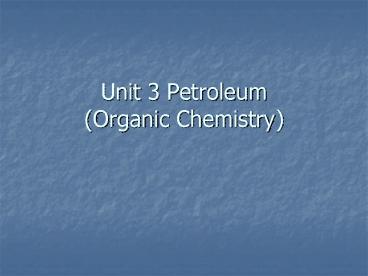Unit 3 Petroleum Organic Chemistry - PowerPoint PPT Presentation
1 / 23
Title:
Unit 3 Petroleum Organic Chemistry
Description:
... generate electricity, power diesel engines and jet aircraft. ... 15-18 C diesel, and industrial heating. 16-20 Lubricants. 20 C don't boil waxes, solids ... – PowerPoint PPT presentation
Number of Views:1848
Avg rating:3.0/5.0
Title: Unit 3 Petroleum Organic Chemistry
1
Unit 3 Petroleum (Organic Chemistry)
2
What is Petroleum?
- In its natural state, it is a complex mixture of
hydrocarbons and other substances, such as water,
sulfides, metals and salts. - Pumped from the ground
- Called crude oil
- A greenish-brown to black liquid
- Viscosity varies from high to low
- A mixture that must be refined before it can be
used - It is a nonrenewable resource
3
Where does petroleum come from?
- Petroleum comes from the ground and we transport
it to refineries
4
What is petroleum made of?
- Hydrocarbons are the simplest of the organic
compounds. As the name suggests, hydrocarbons are
made from hydrogen and carbon.
5
What can we do with petroleum?
- Burning it provides over ½ of the total annual
U.S. energy needs - Most of it is used as fuel in the form of
gasoline - Other petroleum based fuels heat homes, generate
electricity, power diesel engines and jet
aircraft. - Other uses include the production of plastics,
sports equipment, clothing, auto parts,
medications, cosmetics, artificial limbs etc.
6
FACT! OF all the petroleum we use..
- 89 of all petroleum is used for fuel
- 7 is used for new materials and plastics
- 4 for paving and miscellaneous products
7
For every gallon used to produce useful products,
5 are burned for fuel!
- Fuel
- All other plastics and useful products
8
What happens to petroleum that makes it so
valuable?
- When Petroleum is burned, a chemical reaction
occurs. - The atoms are rearranged to form new molecules.
- The burning hydrocarbons produce water and carbon
dioxide (combustion reaction) - The gases disperse into the air .
- It will take millions of years to replace it
9
Combustion reaction of hydrocarbons
10
Who Has it?
- It is not spread equally
11
Separation
- Taking out the good in the goo
- fractional distillation
- Separation by differences in boiling points
12
Simple Distillation
- All based on what temperature something vaporizes
at - The distillates are what is collected at
differing time intervals
13
Steps to refining crude oil
- The crude oil is heated to about 400 degrees.
- The crude is then pumped into a fractional tower,
which is about 100 feet tall. - Some of the crude oil vaporize.
- Trays at different heights collect the condensed
fractions. - The thickest and heaviest molecules never
vaporize, they sink to the base and are drained.
14
Petroleum Refining
- Crude oil is made up of hundreds of different
hydrocarbons - In oil the different groups of similar
hydrocarbons are fractions - Obtaining fractions at a large scale
- Large scale refineries process
- 3 million barrels a day
15
16
(No Transcript)
17
Lets examine the fractions
18
The different fractions
- Gases 1-4 carbons fuels
- 5-12 C motor oil and solvents
- 12-16 C tractor fuel, lamps, and cracking
- 15-18 C diesel, and industrial heating
- 16-20 Lubricants
- 20 C dont boil waxes, solids
19
Gases
- Petroleum's gases have a low boiling point.
- The smallest hydrocarbon molecules with 1-4
carbon atoms are only slightly attracted to each
other. - Because of their low intermolecular attraction,
they separate easily and rise as a gas.
20
Liquids
- Include gasoline, kerosene and heavier oils.
- They have from 5-20 carbon atoms.
- They are divided into light distillates,
intermediate distillates and heavy distillates
based on their boiling points.
21
Examples of each fraction
- Gases Heating oil, petrochemicals, material for
plastics and gasoline additives - Gasoline Heating fuel, natural gasoline for fuel
- Light distillates Aviation gasoline, Kerosene
- Intermediate distillates Furnace oil, diesel
fuel - Heavy Distillates Lubricating oil, grease, wax
- Residues Petroleum jelly, asphalt, road oil
22
How they interact, properties
- Molecules are held together by intermolecular
forces - They attract to one another
- The boiling points can help us group together
similar molecules, and organize them - Page 220 A.5 1-6
23
Density and Viscosity
- The more carbons the higher the viscosity, the
higher intermolecular forces - A measure of how fast or slow a substance flows,
Higher its thicker and slower - Density is also related to the number of carbons
- How does this effect different fractions uses?






























